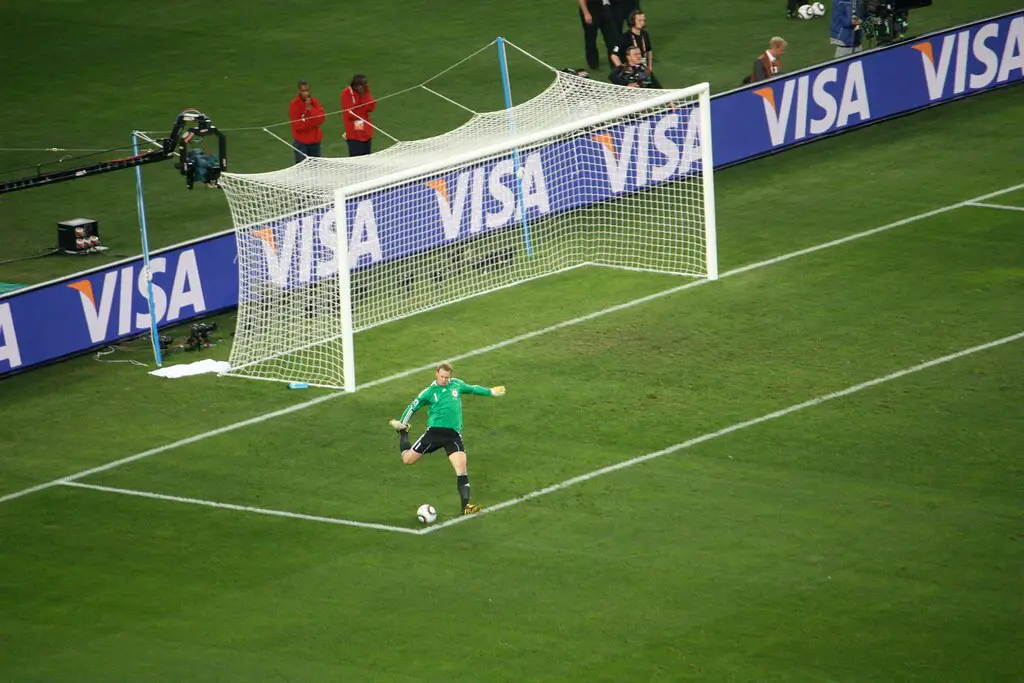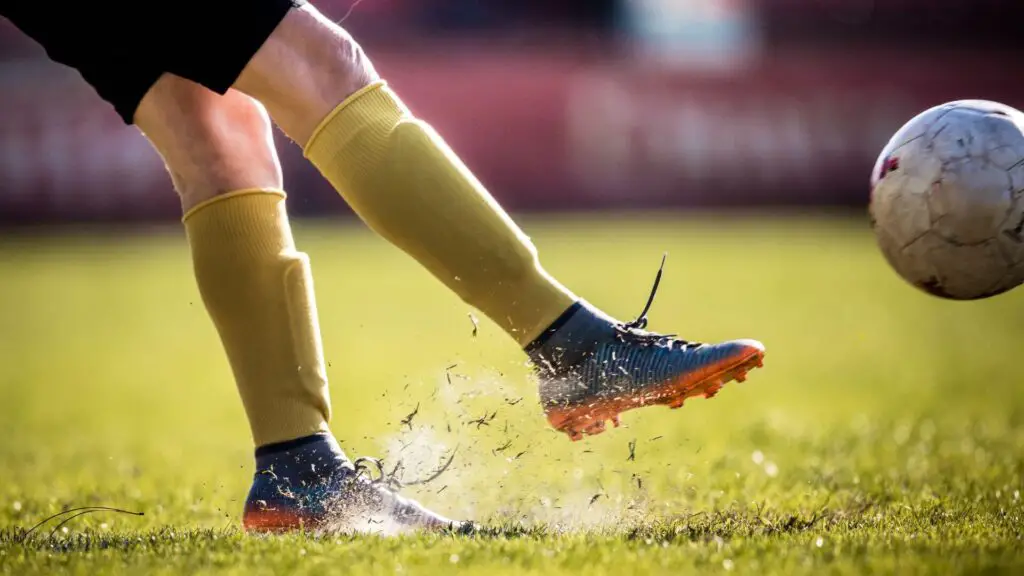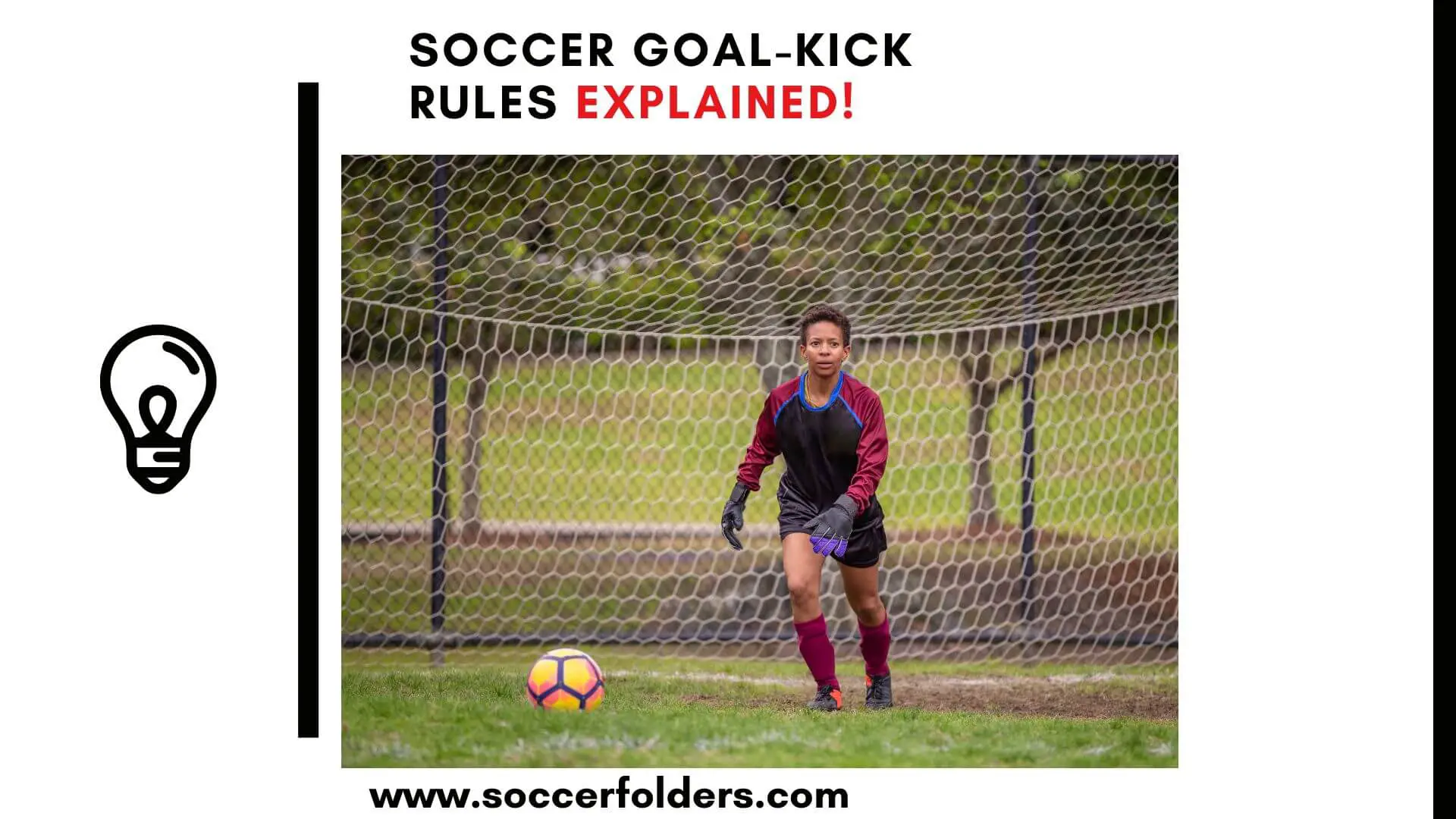During a soccer match, a goal kick can change the game’s outcome with just one swift movement. Although it may seem simple, this action requires a combination of strategy, technique, and following the rules to determine who wins and who loses.
In this comprehensive guide, we delve deep into the world of soccer goal kick rules, uncovering the intricacies that separate the ordinary from the extraordinary.
Whether you’re a player, a coach, or an ardent fan, this article is your key to unlocking the secrets of a masterful goal-kick.
Table Of Contents
- The Basics of the Goal Kick
- Soccer Goal Kick Rules
-
The Goal Kick: Where Strategy Meets Precision
-
Analyzing Professional Players' Goal Kicks
- FAQs About Soccer Goal Kick Rules
- Final Thoughts
The Basics of the Goal Kick
To execute a goal kick, the ball must be stationary within the defending team’s goal area. The kicker has two options: place the ball on the ground and pass it to a teammate or kick it far away. However, the ball is not considered in play until it leaves the penalty area.
Soccer Goal Kick Rules

- The ball must be stationary within the defending team’s goal area before a goal kick can be taken.
- The kicker has the option to place the ball on the ground and kick it or place it anywhere within the six-yard box for a shorter kick.
- Opposing players must remain outside the penalty area until the ball is in play during a goal kick.
- Once the ball leaves the penalty area, it is considered in play, allowing any player to touch it.
- If opposing players enter the penalty area before the ball is kicked, the goal kick may need to be retaken.
- A goal can be scored directly from a goal kick; the ball doesn’t need to make contact with another player before a goal can be awarded.
- Players must adhere to the rules of proper ball placement to optimize the launching point for teammates during a goal kick.
The Goal Kick: Where Strategy Meets Precision
At first glance, a goal kick might appear to be a routine element of a soccer match, but it’s far from it.
It’s a strategic manoeuvre that presents both defensive and offensive opportunities.
The primary objective of a goal kick is for the defending team to restart play from their own goal area after the ball has crossed the goal line without a goal being scored.
Mastering the Art of Goal Kicking
A successful goal kick goes beyond just obeying the rules; it’s a testament to a player’s technique and mental fortitude. The key components that make up a successful goal kick include:
1. Proper Ball Placement
Positioning the ball correctly can be the difference between a swift counterattack and regaining possession. Players should take full advantage of the goal area, positioning the ball to create the best launching point for their teammates downfield.
2. Technique and Accuracy
A powerful and accurate kick requires proper technique. Ensuring the right balance between power and precision is the hallmark of a skilled goal kicker.
Striking the ball’s sweet spot with the laces of the foot can produce a soaring trajectory that pierces through the opposition’s defense.

3. Mental Resilience
Goal kicking is not just a physical act; it’s also a mental challenge. The pressure of the match, the crowd’s energy, and the importance of the situation can all influence a player’s ability to deliver a successful goal kick.
Practising mental focus and resilience during training can greatly enhance a player’s ability to perform under pressure.
Common Mistakes to Avoid During Goal Kicks
Sometimes, players can make mistakes when they’re taking goal kicks.
These mistakes might include not putting the ball in the right place, not talking to teammates, or kicking the ball too hard.
It’s important to know about these mistakes so players can learn from them and do better next time.
Team Communication and Coordination
When a goal kick happens, players need to talk to each other and work together.
They can use signals to show what they’re going to do. Players also need to stand in good spots to receive the kick.
The goalkeeper is like the leader during this time, telling the team what to do and where to kick the ball.
Goal Kick Variations
Teams can try different ways of doing goal kicks. Instead of kicking the ball far, they might kick it short to keep control of the ball. Or they might kick it far to quickly attack the other team.
Sometimes, they can kick it diagonally to go to a special part of the field.
These variations can surprise opponents and give the team an advantage.
Goal Kick Challenges and Solutions
Sometimes, the wind can push the ball in the wrong direction during a goal kick. Or opponents might try to stop the kick.
To solve these problems, players can kick the ball in a certain way to avoid the wind. They can also use teamwork to protect the kicker from opponents.
Role of the Goalkeeper
The goalkeeper is like the “boss” of goal kicks. They decide how to kick the ball and where it should go. They also talk to teammates to make sure everyone knows what to do.
The goalkeeper’s kick can start a strong attack or help the team defend better.
We have seen goalkeepers assisting goals from a simple Goal Kick.
You can also check out CNN to see some examples of soccer goalies who scored from a goal kick.
Training and Practice Drills
To get better at goal kicks, you can practice special drills. These drills can help you learn how to kick accurately, work as a team, and handle the pressure.
One perfect and simple way to train your goal kick on your own is by trying to reach a specific target with the ball. Put your target a bit far away from you and kick the ball with power and precision to try to touch the target.
Do this every day and I can guarantee you that you will get better in no time.
By practising regularly, players can become more confident and skilled at taking goal kicks.
Comparing Goal Kicks with Other Set Pieces
Goal kicks are one type of set piece in soccer. Other set pieces include corner kicks and free kicks.
Each set piece needs a different plan. For example, on a corner kick, the team tries to score by kicking from the corner of the field.
Comparing these set pieces helps players understand different strategies.
Historical Evolution of Goal Kick Rules
Goal kick rules have changed over time.
Long ago, the rules were different from what they are now. Knowing about these changes helps us understand why the rules are the way they are today.
Analyzing Professional Players’ Goal Kicks
Let’s take a closer look at how the pros handle goal kicks in professional matches.
By studying their techniques, choices, and the results of their kicks, we can learn valuable lessons to apply to our own games.
Techniques That Stand Out
Professional goalkeepers and players have some impressive techniques for goal kicks.
They often strike the ball with a part of their foot called the laces. This gives the ball power and accuracy.
When watching closely, you’ll notice that they have a consistent approach to how they stand, how they position the ball, and the way they swing their leg.
Smart Decision-Making
These skilled players make decisions quickly. They assess the situation on the field and decide whether to kick the ball long, short, or to a specific teammate.
They consider the wind, the location of opponents, and the positions of their own teammates. This helps them choose the best option for the team.
Impact on the Game
A well-executed goal kick from a professional player can have a big impact on the game.
A precise kick to a teammate in a good spot can initiate a strong attack, catching the opponents off guard.
On the other hand, a carefully placed long kick can switch the play from one side of the field to the other, giving the team more space to work with.
In some extraordinary moments on the soccer field, goalkeepers have showcased their exceptional skills by not only defending their goal but also contributing to their team’s attack.
There have been instances where goalkeepers, with their powerful and accurate goal kicks, have set up their teammates for scoring opportunities as mentioned earlier.
These instances often result in what’s known as a goalkeeper assist – a pass from the goalkeeper that leads directly to a goal-scoring chance.
Such instances highlight the multifaceted role of goalkeepers, showing their ability to impact both defensive and offensive aspects of the game and serve as inspiration for aspiring players to master the art of goal kicks.
Learning from the Pros
As you watch professional matches, pay attention to how goalkeepers and players handle goal kicks. Try to spot the techniques they use and the decisions they make.
You might notice that they sometimes adjust their techniques based on the situation. Learning from their experiences can help you improve your own goal kicks and make smarter choices during games.
By analyzing how the pros handle goal kicks, we can gain insights into the finer details of this crucial aspect of soccer. These insights can then be applied to our own games, helping us become more skilled and effective players.
FAQs About Soccer Goal Kick Rules
Q1: Does the ball have to leave the box on a goal kick?
Yes, the ball needs to leave the penalty area after a goal kick is taken. Once the ball is outside the penalty area, it’s considered “in play,” meaning any player can touch it. This rule ensures that the ball is moved away from the goal area, giving both teams a fair chance to compete for possession.
Q2: Can a goalkeeper score directly from a goal kick?
Yes, a goalkeeper can indeed score directly from a goal kick. While it’s a rare occurrence, there have been instances where skilful goalkeepers have used the wind and their precise kicking technique to send the ball soaring over the field and into the opponents’ net. This remarkable feat showcases the goalkeeper’s ability to influence the game from their own end of the field.
Q3: Does a goal kick have to be on the line?
No, a goal kick doesn’t have to be taken right on the goal line. The kicker has some flexibility in choosing where to place the ball within the goal area. They can opt for placement anywhere inside the six-yard box to take a shorter kick. This freedom in ball placement allows for strategic options during the goal kick.
Q4: Can any player kick on goal kick?
Yes, any player from the defending team can take a goal kick. It’s not limited to just the goalkeeper. However, goalkeepers are often preferred for goal kicks due to their strong kicking ability and familiarity with the technique. Teams might choose outfield players for goal kicks in certain situations, such as if they need a quick short pass to maintain possession.
Q5: How do you defend a goal kick?
Defending a goal kick involves positioning players strategically to challenge the receiving players from the opposing team. Defenders can mark opponents closely to prevent easy ball control, challenge for headers, and apply pressure to disrupt the opposition’s play. Additionally, defenders should be aware of possible variations in goal kick strategies, such as short kicks, and adjust their positioning accordingly to minimize the opposing team’s options.
Final Thoughts
When it comes to soccer, even the smallest detail can make a big difference. That’s why it’s important to master Goal kick rules. By understanding the complexities and practising the necessary skills, players and teams can turn an ordinary play into a game-winning advantage.
Remember, it’s not just about obeying the rules – it’s about embracing the art and science of goal kicking that adds an extra layer of excitement to the beautiful game we all cherish.
You might also like these articles:

